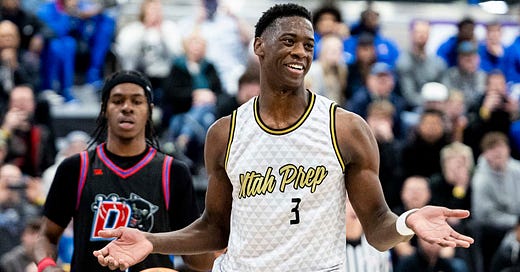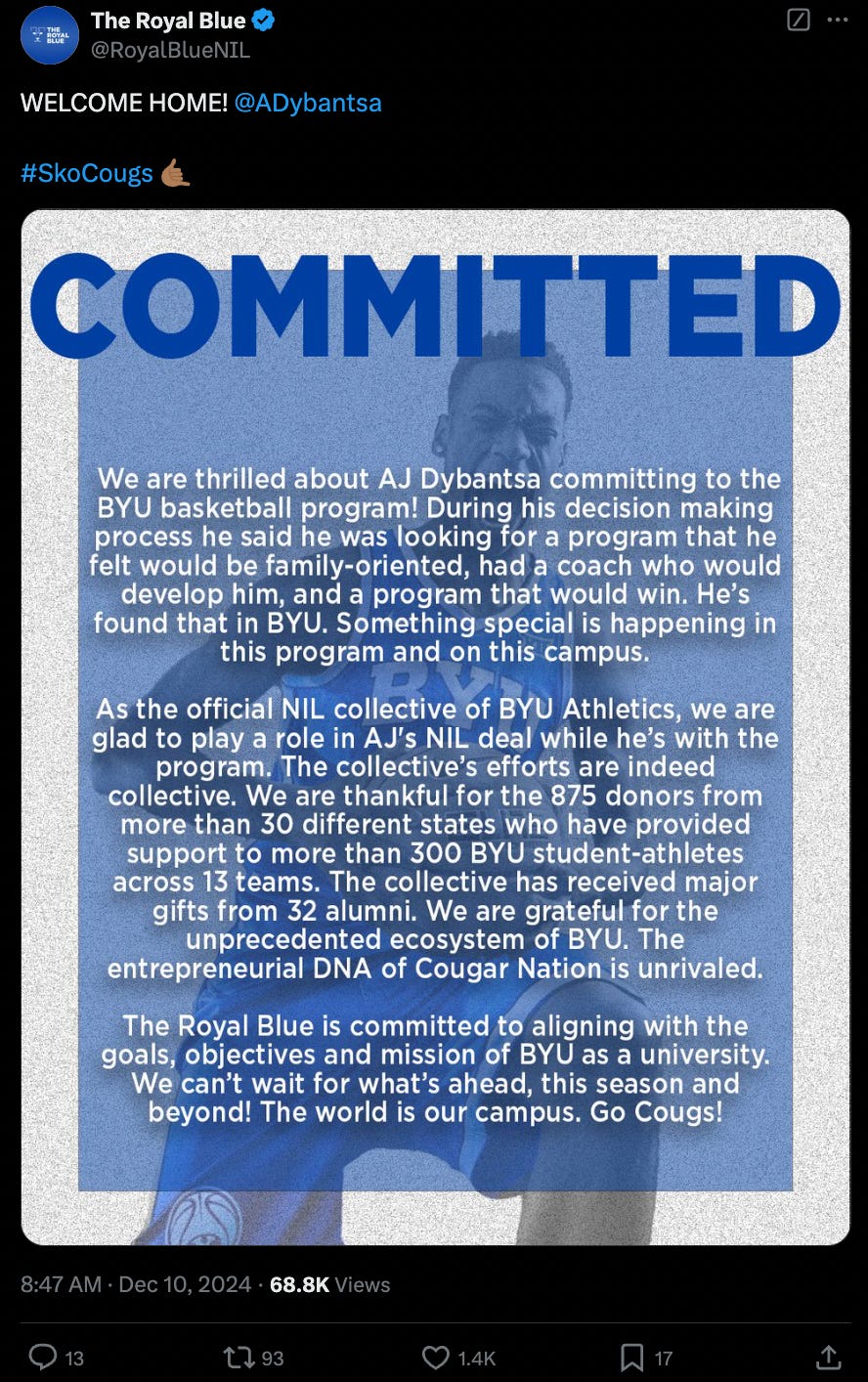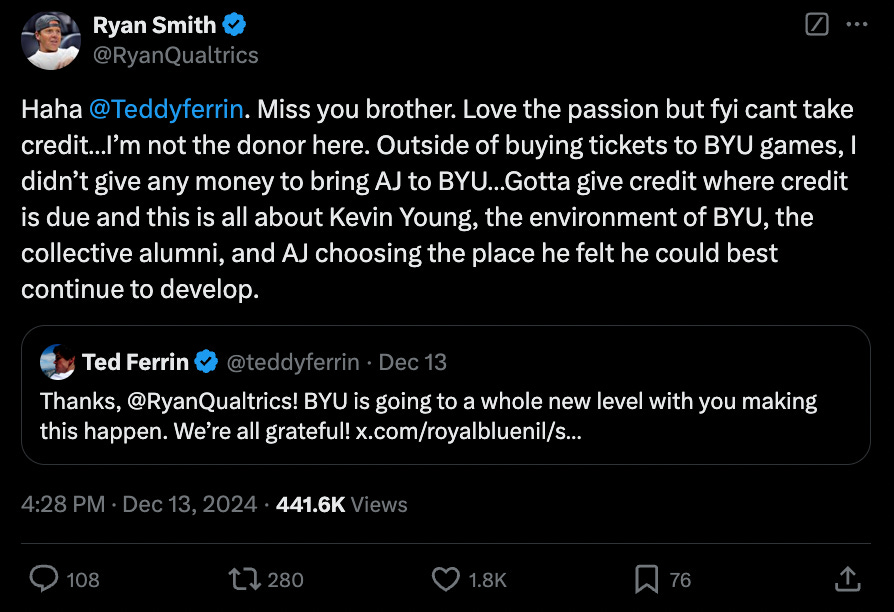The NCAA was formed in 1906 largely to reduce injuries and deaths in football. During this time, the NCAA also created rules around amateurism to prevent professionals from competing for school teams. According to Article VI of the NCAA bylaws, athletes were prevented from attending schools solely due to their athletic abilities and certainly couldn’t be supported because of their athletic gifts.
However, in 1956, the NCAA changed its stance and allowed student-athletes to receive scholarships without regard for academics, largely because under-the-table payments were already happening.
In 1984, the commercialization of college sports hit a significant milestone, though most probably didn’t realize it then. In a 7-2 decision, the Supreme Court ruled that the NCAA’s control of college football TV broadcast rights violated antitrust law, thus giving power to the schools to negotiate rights. As conferences took control of media rights, the floodgates opened for money to be poured into college athletes. I’ve previously touched on this subject while writing about the fall of the Pac-12.
Like anyone who generates value and revenue for a larger entity, student-athletes began wondering why they weren’t receiving a fair share of the pie. In 2009, Ed O’Bannon, a former UCLA basketball player, was a plaintiff in a class action lawsuit against the NCAA claiming that EA Sports used student-athlete’s likeness without consent or compensation. In 2014, Northwestern University football players petitioned to be classified as employees to unionize and benefit from commercial opportunities. These student-athlete uprisings helped start what would become today’s name, image, and likeness (NIL) rights.
In what is largely considered the straw that broke the camel’s back, California passed legislation in 2019 that prohibited the NCAA or member schools from punishing student-athletes for earning compensation because of NIL. Other states followed shortly after.
Finally, in 2021, a Supreme Court ruling stated that the NCAA is not exempt from antitrust law, making it clear that restricting NIL activity could lead to legal challenges.
Said Brett Kavanaugh, the Supreme Court Justice:
“Nowhere else in America can businesses get away with agreeing not to pay their workers a fair market rate on the theory that their product is defined by not paying their workers a fair market rate. And under ordinary principles of antitrust law, it is not evident why college sports should be any different. The NCAA is not above the law.”
Following the Supreme Court ruling, the NCAA quickly adopted NIL policies, paving the way for what we see today. But the NIL rule changes were just the foundation of what is happening now. Student-athletes' ability to optimize monetization opportunities still needed the infrastructure to set the stage. Enter NIL collectives and the transfer portal.
NIL Collectives
Shortly after the NCAA announced NIL rule changes, Darren Heitner, an attorney, received a call from Eddie Rojas, a former Florida baseball player. Rojas had an idea for a business model that pooled together cash from boosters to provide student-athletes with NIL opportunities. About a month later, the Gator Collective was formed. Shortly thereafter, other collectives were also formed. Today, every Power Five school has a collective and about two-thirds of D1 schools have one.
Technically, collectives are independent of universities, but the whole point is to provide easy ways for athletes to monetize their name, image, and likeness. Some collectives are more of a marketplace for student-athletes to connect with commercial opportunities. More often though, they are set up as cash funds to pay student-athletes in NCAA-compliant ways.
The Transfer Portal
Not too long ago, transferring as a student-athlete from one school to another was relatively rare. With a few exceptions, transfers were required to sit out a year due to NCAA rules. This rule was largely created to reduce the number of transfers and maintain the competitive balance of collegiate sports.
In 2021 the NCAA changed the rule to allow student-athletes to transfer one time during their collegiate career and be allowed to play immediately. Then in early 2024, the Department of Justice and multiple states challenged the NCAA’s transfer rule stating it violated antitrust law. The NCAA caved and changed its rule to allow student-athletes to transfer as many times as they wanted as long as their eligibility remained.
The result is thousands of student-athletes entering the transfer portal. The data is pretty difficult to track down (multiple sources quote different numbers), but it’s safe to say that in 2023 at least 15-20k student-athletes entered the transfer portal. While many were searching for more playing time, a large percentage never signed with a new team, ending their sports careers on the spot. Despite the vast majority transferring to earn more playing time, the top 1% are doing so to secure better NIL deals after outstanding play.
As one former Wake Forest football player put it:
“There’s been a shift from a team perspective to a really individualistic perspective, which is certainly unhealthy.”
The Perfect Storm
With the new NIL rights, NIL collectives, and the revamped transfer portal, we have the perfect storm. What was considered amateurism just a few years ago, college athletics now resembles professional sports with features such as free agency and salaries.
Just last week, AJ Dybantsa, the nation's top basketball recruit, signed with BYU—a school that hasn’t generated basketball buzz since Jimmer Fredette’s time on campus.
BYU’s NIL collective, The Royal Blue, is suspected to have one of the largest funds in college sports. It has been reported that every BYU football player is being paid by the collective. Still, BYU basketball has gained all the headlines lately.
Dybantsa is reportedly being paid somewhere between $5-7 million [ref, ref] to play at BYU, making him one of, if not the highest-paid student-athlete to date (I’m sure this figure will continue to grow every year). It's not a bad gig to spend less than a year on campus before jumping to the NBA. To put that number in perspective, the median NBA salary this year is $6.6 million.
This year, Egor Demin, a projected lottery pick, was scooped up from BYU from Real Madrid after securing a reported $1.5 million from The Royal Blue.
A major part of BYU basketball winning over highly touted recruits is because of its new coach, Kevin Young. Having earned his stripes in NBA circles, players trust he can help them reach their dream of the NBA. But the money cannot be ignored and is likely the number one reason top recruits are choosing BYU.
It has been reported that the big money is coming from Ryan Smith, the billionaire owner of the Utah Jazz and BYU dropout (though he did finish it later). Smith has expressed his desire to help BYU basketball build a winning culture. Adrian Wojnarowski has said that Young has been given “all the resources to win big” at BYU, citing Smith as a key component of those resources.
Smith took to X after Dybantsa signed with BYU to downplay his involvement, even saying he wasn’t the donor that helped bring the number one recruit to Provo, Utah. I’m not sure I totally buy it, but his comments do give us a glimpse inside BYU’s NIL collective and how large and powerful it can become in creating teams that can compete for championships.
Rising Pay of Student-Athletes
My biggest takeaway from the arrival of NIL rights, NIL collectives, and the open transfer portal is that compensation for the best student-athletes will continue to rise. It is projected that the total NIL market for this year’s sports seasons will be $1.67 billion. For the 2025-26 seasons, the total market is expected to grow to $2.5 billion with the addition of student-athlete revenue-sharing that athletic departments will be able to pay its athletes (up to a $20.5 million cap).
In professional sports, front offices must be rational in how much they pay a player. Leagues have salary caps (at least in the NBA and NFL) and you need to ensure the value of a player justifies what you pay.
For college NIL deals, boosters don’t need to be as rational as professional teams. There is no salary cap for NIL collectives. All they care about is winning. They can continue to throw more and more money at student-athletes as long as boosters keep donating, merchandise sales continue, and licensing deals don’t dry up.
It is not far-fetched to think that the best college athletes will be making as much as and possibly more than professional athletes soon. A few years ago, we said a $1 million NIL deal for Bryce Young was insane. Now, just a little over three years later, Dybantsa is reportedly getting up to seven times what Young received.
If the same trajectory continues, can you imagine where the top NIL deals will be in another three years? There may even be monetary incentives that keep kids in school instead of jumping to the pros.
Now, the whole NIL space is like the Wild Wild West right now and everything can change if there are suddenly new rules introduced. However, all of the recent rulings against the NCAA are pointing towards an open market. Buckle up, we may be in for some insane paydays for the next crop of 18-year-old phenoms.









